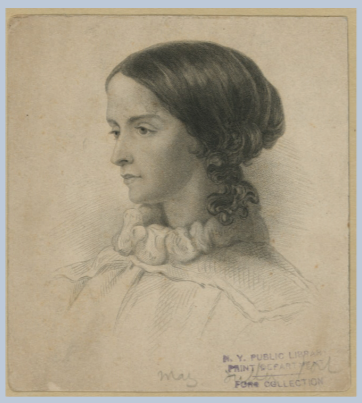4.16: Margaret Fuller (1810–1850)
- Page ID
- 57478
Sarah Margaret Fuller was born at Cambridgeport, now part of Cambridge. She was educated by her father, a lawyer and congressman, in the classics. Although she later described her childhood as stressful, she nevertheless appreciated her father’s interest in developing her mind for its own sake rather than as an ornament to an “inevitable” future husband and married household. Her mind developed rapidly, as she achieved a thorough reading in such classic authors Virgil, Ovid, Horace, and Shakespeare by the time she was ten years old.

Image \(\PageIndex{1}\): Sarah Margaret Fuller
In 1824, she was sent to a finishing school in Groton before returning to live with her family in Cambridge. She still continued her intellectual development, reading German philosophers and European Romantics, publishing the essay “In Defense of Brutus” (1834) in Boston Daily Advertiser, and translating Johann Wolfgang von Goethe’s (1749–1832) Torquato Tasso (1833). These activities were disrupted when her father died of cholera and Fuller was made responsible for supporting her mother and eight siblings. She taught at Bronson Alcott’s progressive-minded, co-educational Boston Temple School. After that school closed, Fuller taught at the Greene Street School in Providence, Rhode Island. She also maintained her literary ambitions, publishing essays and translations in Boston and the Western Messenger.
Once freed from her familial responsibilities, Fuller returned to Cambridge where she supported herself and promoted other Boston and Cambridge women’s intellectual growth holding “Conversations” on such rigorous subjects as Greek mythology, ethics, philosophical idealism, and women’s rights. She became interested in the utopian community of Brook Farm and joined a circle of social reformers, including Lydia Maria Child, and of Transcendentalists, including Emerson and Thoreau. With Emerson, she founded the Transcendentalist journal The Dial and served as its editor from 1840 to 1842. The next year, The Dial published Fuller’s groundbreaking essay “The Great Lawsuit. Man versus Men. Woman versus Women” (1843). Drawing upon Transcendentalist ideas on nature, the spirit, self-perfection, and true creation, as well as displaying her wideranging scholarship in European literature and culture, this essay prophesied true independence for women, once freed from limiting patriarchal systems and institutions with their false and hierarchical gender divisions.
After traveling around the Great Lakes and what was then the far Western frontier, Fuller published Summer on the Lakes, in 1843 (1844); a collection of her poetry; travel sketches; and thoughts on the detriments of industrialization, women’s survival on the frontier, injustices to the Native Americans and other subjects. On the strength of this book, Horace Greeley, editor of the New-York Tribune, offered her a position as its literary editor. She became an influential literary critic, publishing over 250 pieces during the four years she worked there, and bringing notice to Poe, Hawthorne, Melville, and Frederick Douglass, among others. She also brought notice to ill treatment of the disabled, the insane, and the imprisoned.
She enlarged her essay “The Great Lawsuit” into the book-length Woman in the Nineteenth Century (1845). In it, she advocated physical, mental, and spiritual equality for women, including freeing women from marriage as an economic necessity. She also paralleled the patriarchal oppression of women with that of slaves. Praised by Lydia Maria Child and later by Elizabeth Cady Stanton and Susan B. Anthony, the book is now considered a landmark in feminist thought in America.
In 1846, she traveled to Europe as a foreign correspondent for the New-York Tribune. She became a staunch supporter of Italian unification, or Risorgimento. She worked in a hospital for wounded revolutionaries fighting for the (ultimatelyfailed) independent Roman Republic sought by the Giuseppe Mazzini. She also fell in love with a fellow supporter of Mazzini, the Marchese Giovanni Angelo Ossoli. The two had a son, lived together for a time in Florence, then sought economic opportunities by sailing to America in 1850. Their ship wrecked and sank near Fire Island, New York, drowning Fuller, Ossoli, and their child.

